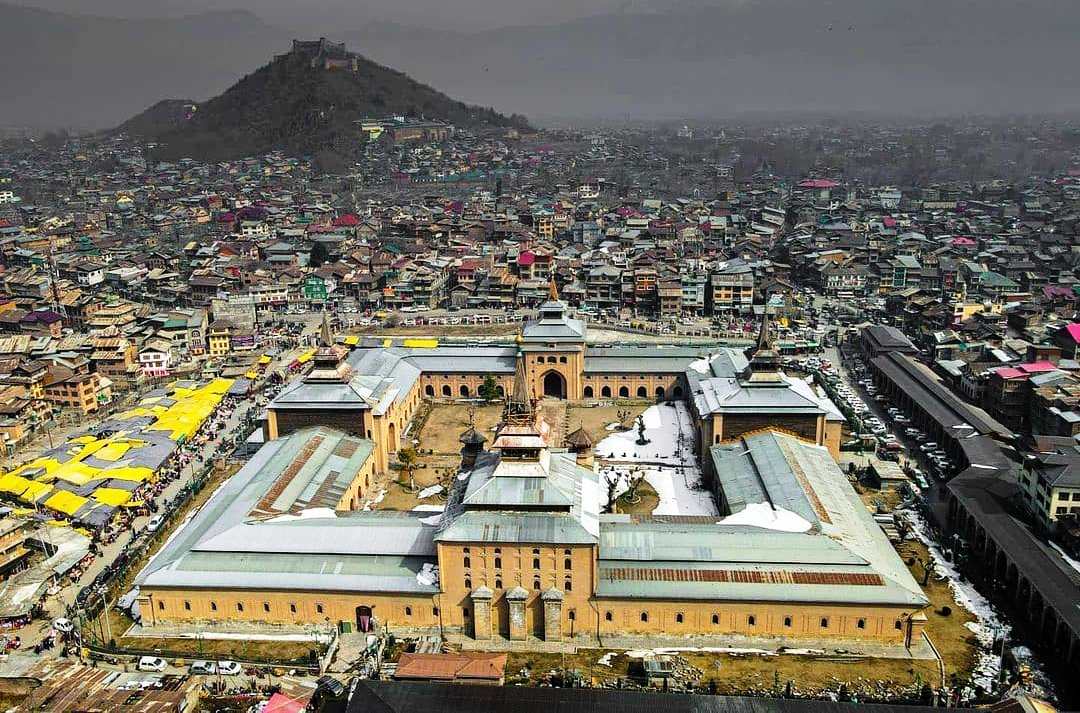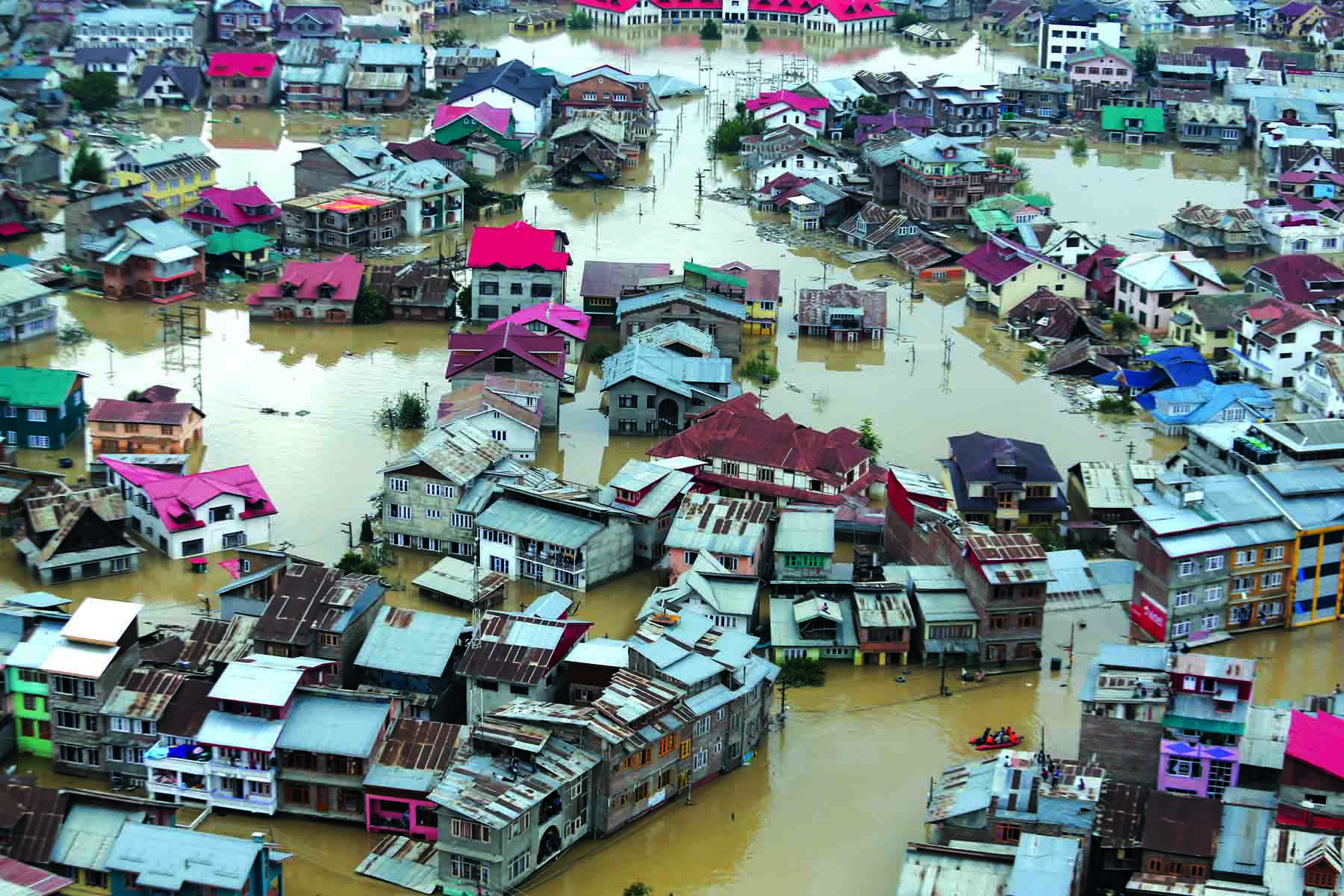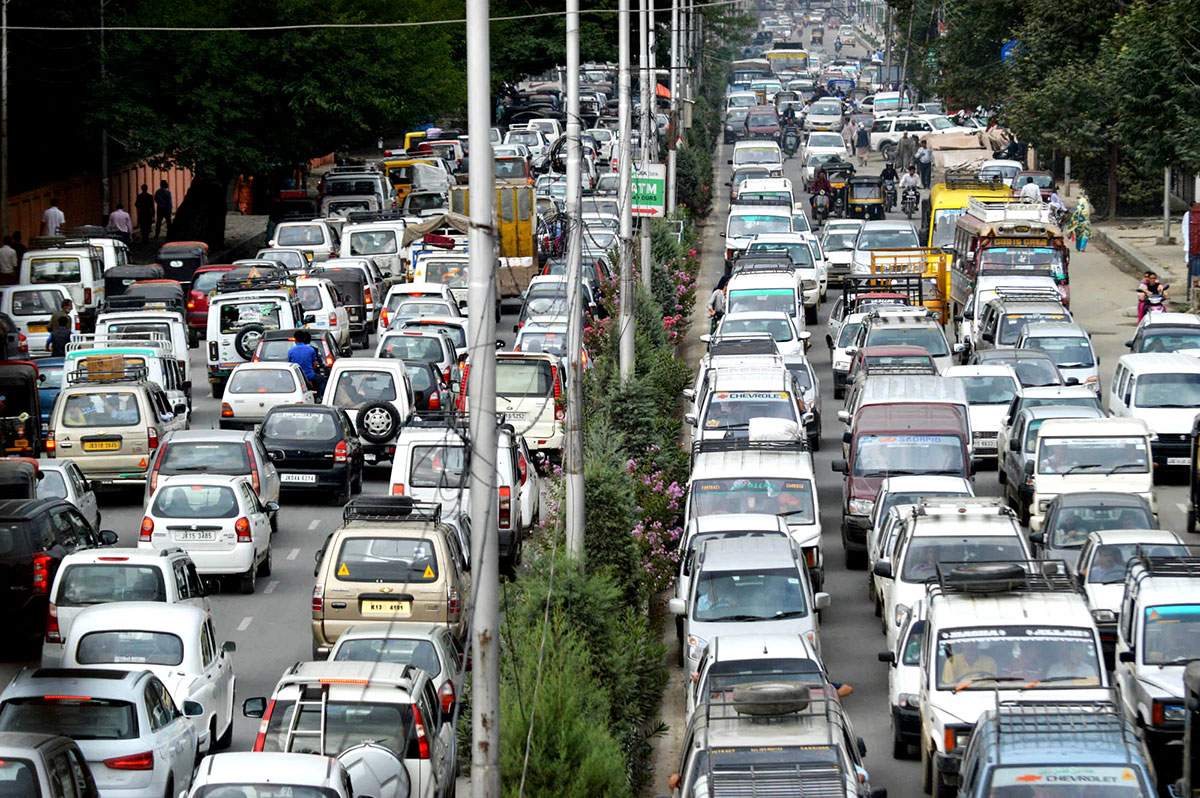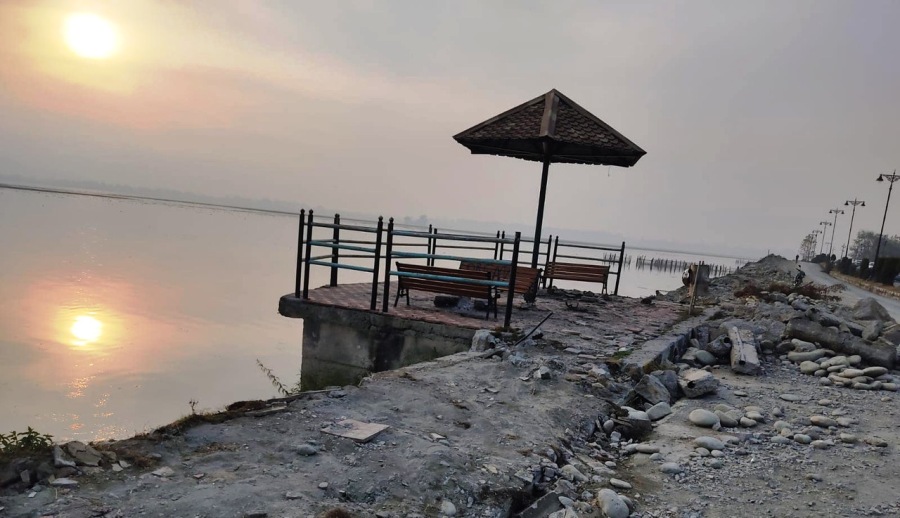A lot of resources are being pumped to redo parts of Srinagar city to make it smart. Quite a few projects, however, will address the key crippling challenges that the UNESCO-accredited Creative City, faces Yawar Hussain reports

Srinagar, the city of Kashmir is dug up almost everywhere. From the city centre in Lal Chowk to the tourist hub around Dal lake and to the bund on the Jhelum, almost everywhere men and machines are at work. Officially, the Smart City is in making. However, the timing for re-creating Srinagar is something that is being discussed widely because the winters have set in and life is expected to remain jammed for many months.
The debate is about what the Smart City will look like and how will it impact the lives of nearly 2.3 million odd people (including the floating population) living in the city. Will the smartness offer the house to the poor? Will there be more job opportunities? How will the new city improve the key deficits in energy and water? Where will the new roads be laid or is there a rapid mass transportation part of the new design of the city that was founded by King Pravarasena II, more than 400 years before Jesus Christ was born?
Ideally, Smart City is a technologically aided society that uses ICT-enabled services to collect data about individuals, institutions and services to improve the living conditions of the inhabitants. The Smart City Mission in India is aimed at promoting cities to provide core infrastructure, clean and sustainable environment and give a decent quality of life to their citizens through the application of ‘smart solutions’. The Central Sponsored Scheme (CSS) “aims to drive economic growth and improve quality of life through comprehensive work on social, economic, physical and institutional pillars of the city” in which the focus is on “sustainable and inclusive development”.
The project awarded to Srinagar in 2017 in the BJPDP era drew criticism initially for the government’s failure in having a full-fledged Chief Executive Officer (CEO). It even led to lapsing of funds for some time. With this tension almost addressed, the project is now drawing criticism on whether it would make the city as smart or lifeless as it seems.
The Projects
The smart city project, which has June 2023 as the deadline, has taken up three areas of the city including Shehr-e-Khaas, Lal chowk and adjoining places along with the Dal Lake and the places around it under the Area-Based Development plan. The works, in the upcoming months, would be taken up in these areas, many of which are currently underway. Under the Smart City, works, barring a few, aren’t meant for all the areas of the city.

The Project, which has a Rs 3000-crore odd budget, has Rs 2000 crores allotted for the line departments, which are working in convergence with Smart City Limited on various projects. Smart City Limited on its own has a budget of around Rs 1000 crore.
Apart from the Area-Based Development programme, the Smart City project is also working on a few pan-city projects like the interventions in the IT-related sectors along with improving certain roads and urban mobility which includes the public transport facilities across the city.
As per the government of India’s Smart City scheme, the central government over five years would pay a selected city Rs 500 crore while the state/union territory would pay an equal amount within the same time frame.
With Srinagar receiving funding of around Rs 1000 crore from both sources, the other projects worth Rs 2000 crore are being done under convergence with line departments which anyhow would have taken up those works.
As per official figures, the funds to Srinagar Smart City to date from the union government is Rs 195 crore out of which Rs 125 crore have been transferred. The utilisation certificate has been provided for Rs 120 crore. For Jammu, the union government has released the same amount so far. The union territory government has released Rs 84 crore to date for the Srinagar Smart City while in Jammu Rs 126 crore have been released.
The project envisages the setting upjhelu of 5-bin Segregation Systems for Solid Waste Management to improve the city’s sanitation conditions. Officially, the Rs 3.96 crore project is completed but the five bins are nowhere in sight in the jurisdiction of the Srinagar Municipal Corporation (SMC), which was given the implementation job.
Srinagar is crowded with street hawkers. It is fundamental to the livelihood of tens of thousands of people. Under the Smart City mission, Rs 4.6 crore was spent on the hawker’s zone near Magarmal. There is an assembly of red sheds fitted with solar panels. Nobody knows if it ever will be operational. Even if it is, will this small zone get the clientele to the spot, which is a no-parking zone?
Rapid Transport
Srinagar has a malignant public transport system. Ever since the phasing out of matador-min-buses, almost two-thirds of Srinagar lacks a bus service. The mini-buses ply on main roads only unlike the earlier ones that would navigate almost two-thirds of Srinagar localities. This crisis has given birth to mushrooming of auto culture and a massive appetite for the personal car.

Off late, the TATA Sumo services had started filling the void. However, the crackdown on these services has marked the end of the private sector initiative. Now entering Srinagar is a costly affair. After dusk, authorities’ failure to ensure mini-buses available on key routes has converted Srinagar into a ‘sunset city’.
Smart City project has set aside Rs 3 crore for introducing electric autos. Some of these battery-operated autos are seen efficiently working between Batamaloo and Dal Gate.
Besides, the smart city mission has placed an order with Tata Motors for new 100 electric buses worth Rs 198 crore. However, the 20 buses bought in April 2019 from the same manufacturer have only 12 operational as eight of them are fighting snags and are dysfunctional. These buses were off the road post-August 5 and then also during the Covid-19 induced lockdowns. But still, the automaker will supply 75 nine-meter Starbus electric buses and 25 twelve-meter Starbus electric buses.
With limited roads and immense pressures, triggered mostly by personal cars, regulating traffic has emerged as a bigger concern for the city managers than making basic public transport available. The Smart City project has spent Rs 50 crore on installing the Intelligent Traffic Management System which included upgrading the signals on important intersections and installing new traffic lights. Most of these lights – outside the MA Road – Residency Road belt – operate either on as-they-please mode or are manipulated by the managers.
The project has an ambitious plan for reviving water transport for which Rs 3 crore is already spent. Barring a joyride for media on a ferry in Jhelum in early 2020, has there been some improvement?
The Baba Dem lagoon is a dump now. Since the 1990s, it has shrunken from over 5 sq km to 0.75 in the last three decades. The smart city has claimed to have spent Rs 24 crore through the UEED and LCMA on improving the quality of water of Baba Dem lagoon. It still smells foul.
The famed Dal Lake, the project suggests has seen Rs 7.84 crore being spent on cleaning and de-silting the canals leading towards the lake. The mission has funded an Aeration Fountain with a light and sound show for Rs 2.5 crore. The new iron lights along the banks of Dal Lake, which replaced the aesthetic cement ones, have also been installed under the project for Rs 9.98 crore. It has not changed much of the lake.
“This area has gone from bad to worse since my childhood. Nothing has been constant except for deterioration and encroachment of the lake,” Mir Adil, a resident of Nehru Park said.
The project has also spent Rs 16 lakhs on the rejuvenation of Gilsar Lake through the Irrigation and Flood Control Department.

On building pedestrian walkways and footpaths, the Smart City project has spent Rs 14.74 crore already. It plans to build more pedestrian pathways and cycle tracks in the heritage precinct of Nowhatta to Hawal Road to 90-feet Road with five Chowks. The project has been tendered for Rs 38 crore. The project would also have tactile improvements at Sher-e-Kashmir Park, Jahangir Chowk junction along with a proposed cycle track on Fore Shore Road. The initial cost of this project is Rs 69 lakhs. The beautiful and robust iron grill along Fore Shore Road was dismantled following this project.
To change the façade of the bunkers in the city, the project would spend Rs 30 lakhs to make them “aesthetically good-looking”. Also, an emergency response system would be built for “improved safety and security of women, children and elders for Rs 10 crore.
The already done beautification of the flyovers, grade separators and other such infrastructure in Srinagar City has cost Rs 2 crore.
The project would also see the building of the Sher-Garhi International Centre for Rs 80 crore by the department of Archaeology in the 18th-century Kashmir’s Afghan-era secretariat. The project initially envisaged in 2015 was shrouded in historical controversy. Under the project, a Red Cross Bhawan (Smart Health Centre and Tele- Medicines) will be built for Rs 3.5 crore.
On the redevelopment of Food Corporation of India’s Godowns in Srinagar, the Smarty City scheme has spent Rs 10.5 crore so far.
On the My-Srinagar application, with just 1000 odd downloads, the mission has spent Rs 1.5 crore. The application has clubbed together the links of various facilities, which on clicking takes one to the parent website.
The Smart City Mission has also upgraded the existing electrical systems in various shrines in Srinagar city for Rs 2.5 crore along with installing LED flood lights at main crossings and chowks of Srinagar for Rs 7.15 cr.
The project has Rs 8 crore for a Property Development System in the city along with an abattoir with a waste management system being built for Rs 28 crore.
With snow halting the city whenever it falls, the Smart City Project has already claimed to have bought all-weather cabin-fitted 4×4 tractors with snow ploughs through SMC for Rs 5.25 Cr.
By March 2023, Srinagar’s Polo View market, established in 1954 by erstwhile Prime Minister, Bakshi Ghulam Mohammad, will have a new look with Rs 5 crore odd spent on it by then. But would its mighty Chinars survive, remains a question for the future. As per Chinar Development Officer, Tariq ul Habib, the laid guidelines state that no construction work should be taken at a place nearby a Chinar.
“There has to be a 40 feet demarcation at a place beholding Chinar where construction work has to be taken up,” he said.
For the round-the-clock water supply in the city, the Smart City mission has already spent Rs 263.5 crore. This comes on the heels of reports of drinking water shortage in Srinagar areas during summer.
The road stretch from Tourist Reception Centre (TRC) to Residency Road, including the Lal Chowk area, is being redeveloped. At the place of Concrete Park, a plaza will be put in place, a place where people can walk and sit.
The redevelopment project for Residency Road would have a sidewalk and a uniform carriageway along with underground cables for communication and electricity. Redesigning the on-street parking will also be done.
With the city lacking bridges connecting uptown with Sher-e-Khaas and city centre Lal Chowk, the Srinagar Smart City Limited has spent Rs 2.92 crore on the illumination of bridges, advertisement panels and dashboards display on street lights under the phase-I.
Chief Executive Officer Smart City Iftikhar Kakroo said that the project can’t be pan-city because then the works wouldn’t bring in a visible change which Area-Based or specific works would bring.
“It is a project which aims to fill in the gaps between what is already built and what is required at a certain place,” Kakroo said, adding that the net changes would be visible in the three areas selected under the Area-Based Development plan along with pan city works under the urban mobility and IT interventions.
On funding, Kakroo said that the project is in demand driven by the government sanctioning funds for the works taken up by the company. “Till now the cost of the project has been around Rs 983 crores.”
Inherent Problems
For most of the last 250 years till the early twentieth century, Srinagar’s challenges were described by 3Fs and an E. It was too frequent epidemics, fires, floods and famines. With the fall of the despots, and the rapid changes in the socio-economic profile, the city has managed the epidemics, essentially the outcome of municipal affairs, and the rest of the challenges survived. In fact, the list only improved. Right now transportation is a major crisis.
The conversion of the Presentation Convent-General Post Office bridge into a footbridge along with shunning away the idea of making the Old-Zero bridge available for light-motor vehicles has only added to the problems of the daily commuters in Srinagar. The smart city mission is silent on building any new bridges which might ease a stuck city.
The two-way road bridge over the Jhelum in Pandrethan, meant to connect dozens of localities, is still not completed for lack of funds.
The bridge would connect Lasjan, Soibugh, Padshahibagh and many other areas on the bypass with Athwajan, Batwara, Sonwar, and Pantha Chowk and make travel easier.
With its dilapidated roads, which haven’t seen any widening in decades, traffic jams are a consistent feature in Srinagar. Home to 1.7 million residents and home to Kashmir’s governance and commerce, the smart city mission lacks a focus on this key deficit. Will the intersection redevelopment and installation of an “intelligent” traffic lights system help address this void?
The Traffic Police are keeping the road show going with ugly plastic dividers, new diversions, costly rerouting and hefty penalties. Poor planning is the major problem. The city’s road networks, the 2035 master plan noted, “is cramped because of missing links, incomplete rings, inefficient radials, bottlenecks, etc” with many dead-ends that connect to no major arterial roads for smooth flow of traffic. However, the smart city project hasn’t taken this into consideration and doesn’t have a project to widen any road.
The master plan, however, discourages the road widening “in view of the potential loss to heritage” except in areas where it is “inevitable”.
Srinagar has expanded haphazardly over the years in the absence of governmental checks and balances. The city’s layout is planned on a radial model but, the master plan’s Land Use and Traffic and Transportation Survey observed, “all the radials are witnessing extreme traffic flows much beyond their capacities, hence the poor level of service.”
The report also noted the administration’s incompetence in implementing two previous traffic management plans: “not a single step has been taken so far” to implement the Srinagar Urban Transport Project of 1992 and the Comprehensive Mobility Plan (CMP) of 2012 by Rail India Technical and Economic Services.
The city’s population grows by around 2.3 per cent a year. But the vehicular population grows by seven per cent.
“Traffic congestion is already severe on many city roads and the gridlock plaguing Srinagar has reached a tipping point, with the region spending millions of man hours in traffic congestion each year,” the report states. “The city road network needs a complete relook so that an efficient and sustainable transport network is developed to cater to the future demand.”
Municipal Affairs
Srinagar is a formal municipality since 1886. Later, Srinagar expanded rapidly leading to drainage problems in the next century which still exist.
Though medieval rulers built their capitals within the city population, post-Mughal era conquers and despots choose to inhabit the river banks as they were away from populations. The Residency, Presentation Convent, Mallinson School and Residency Road, Hari Singh High Street and many other areas came into being only after the Afghan era. These facilities led to the city expanding with the flood basin.
Erstwhile British resident, Younghusband visited Kashmir Kashmir during a flood. A prolific writer, he recorded that he boarded the boat at Shalteng and entered the second story of Nedou’s Hotel as its ground floor was underwater. Later, Maharaja Partap Singh built embankments on either side of Jhelum passing through the city on the advice of British engineers, but Sir Walter Lawerence, the then Settlement Commissioner, commented that it was a great folly to restrict the width of the river Jhelum, as one day it will break through its banks in floods, which came true after about a century of his prediction in September 2014.
Post-2014, an expectation was that the governments will forbid the construction of housing settlements within the flood basin. Now, the entire belts are being filled up to raise new buildings.
Even the drainage is in mess. Srinagar has 650 km of drains which is 1000 km short of the requirement. In a workshop of the Institution of Engineers, experts said Srinagar had 1650kms of drains to drain out stormwater and sewage.
“The outfall is mostly managed by 85 permanent and 35 temporary mechanical dewatering stations besides gravity outfall channels,” Er Sheikh Sajid Yaseen revealed. The workshop was informed that raw sewage was being pumped into water bodies through drains which damaged the ecology of the water bodies. “Due to high courts’ intervention, pumping of raw sewage into Dal Lake has been stopped to large extent,” another official said.
As per the data available with SMC, Srinagar city generates 170 million litres per day (MLD) of sewage while having a capacity for sewage treatment of 53.20 MLD.
Also, the official data reveals that more than half of Srinagar areas still don’t have drainage facilities available.
Dr M Sultan Bhat, Professor of Geography and Disaster Management at Kashmir University said that a lot of measures need to be taken by the government to mitigate the flood hazard.
“Important one is dredging of river Jhelum and small tributaries. The intake capacity of the river needs to be increased so that it can intake more quantity of water in it,” Bhat said. “Earlier, wetlands used to absorb a lot of water but now they too have been encroached upon. I believe Wular lake needs dredging as during the 2014 floods it was also pushing back the water.”
Interestingly, however, the smart city mission has envisaged River Bank Development through the Irrigation and Flood Control Department, Kashmir for which Rs 358 crore have been spent. Barring Gilsar, no water body or wetland has been identified by the mission for any work.
Dog Menace
Even though municipal affair failure has not revived the epidemics, it has, instead made Srinagar, the capital of pariahs. Till October this year, 41 persons including 9 tourists were bitten by dogs around Boulevard Road and Dal Lake alone. The attacks have left both tourists and locals terrified.
In between April 2019 and February 2020, 3,975 out of the 6,319 cases of dog bites took place in Srinagar. In the last five years, 30,000 dog bite cases have been reported at Shri Maharaja Hari Singh Hospital (SMHS) alone, of which 2,800 cases were reported in Srinagar only.
A few years ago, an eight-month-old baby died at a Srinagar hospital, three weeks after she was mauled by stray dogs. Baby Shafia Ahad was sleeping at her home in the Shanpora locality of Habak in Srinagar when dogs jumped in through a window and attacked her.
This year, a minor orphan in Chanapora was almost killed by a pack of dogs when he was on his way to offer Fateha for his father who had passed away a month ago.
The doctors had stated that the chances of the kid’s survival were minimal but after several injuries, he sailed through.
The smart city project is conspicuously silent on the menace.
Green Spaces
Every city needs lungs to breathe and Srinagar’s per capita green spaces are the lowest in India. There are 169 parks spread over 287 hectares in Srinagar city but the minimum requirement, according to Urban and Regional Development Plans Formulation and Implementation (URDPFI) guidelines, 2015 is 570 hectares. It is a whopping 50 per cent deficit and still, Srinagar attracted 23 lakh tourists! Against the World Health Organization (WHO) recommendation that cities must provide nine square metres of unpaved open space for every inhabitant, Srinagar has only 2.6 sq meters. It suggests designing green area networks so that all residents live within a 15-minute walk of open space.
Under the smart city mission, green corridors have been built in Bemina and Baghe-Mehtab on the outskirts of Srinagar at a cost of Rs 5.52 crore. However, the Sher-e-Khaas is the worst affected by the lack of green spaces. Even uptown Srinagar sails in the same boat.
Difficult City
These issues are fundamental to the ranking of a city that everybody admired as the Venice of the East.
In the Ease of Living Index 2020, Srinagar is the last at No 49 among cities with more than a million residents. Even Jammu (score 52.49) is at 27, almost halfway up than Srinagar (42.95).
Previously, Jammu was at 95 and Srinagar at 100 on the list of 111 cities.
The performance of the cities was measured on four broad parameters – governance, social, physical and economic infrastructure. Srinagar’s score is way behind the all-India average of 53.51.
In the Municipal Performance Index (MPI) 2020, Srinagar scored poorer. It got only 25.93 points out of 100.
New Projects
These indicators do not make a priority for the smart city mission. Skipping the key challenges, the mission has numerous projects in the pipeline which are expected to be taken up soon.
For building Wi-Fi hubs, a tender of Rs 16 crore was floated along with an additional Rs 33 crore for water transport terminals, ticket counters and other amenities being built along the river Jhelum.
For retrofitting and conservation of heritage buildings Rs 4.66 crore would be spent while the Detailed Project Report (DPR) of Rs 2.94 crore for the power corridor of Gupkar road has been approved.
The bicycle sharing scheme, a success in Jammu city, has been tendered for Rs 6.35 crore. For traffic management, the DPR of Rs 41.34 crore for Smart Bus stops has been approved.
A traditional Souq Market and Craft Centre would also be built at sector 6 Batamaloo for Rs 31.22 crore. A DPR for Rs 9 crore has been approved for Pink and Smart Toilets at various places. Along with the development of Batamaloo-Mominabad Bypass Road for Rs 10.24 crore, an improvement and upgradation of markets/streets/roads of Nawakadal, Aali Kadal, Rajouri Kadal, Maharaj Gunj, Zaina Kadal is being taken up for Rs 22.92 crore. Also, the markets/streets/roads of Malaratta, Nowhatta, Naqashband Sahib, Saraf Kadal, Rajouri Kadal, and Jamia Masjid will be upgraded for Rs 12.28 crore. The development of the Batamaloo-Qammarwari road for Rs 14.61 crore will also be undertaken.
Also, 12 garbage transfer stations will be built for Rs 36 crore while signage boards would be put up for Rs 13.8 crore. A wooden pedestrian bridge on the existing piers of Old Amira Kadal would be built for Rs 7.14 crore.
from Kashmir Life https://ift.tt/SxsjKAl
via IFTTThttps://kashmirlife.net
No comments:
Post a Comment